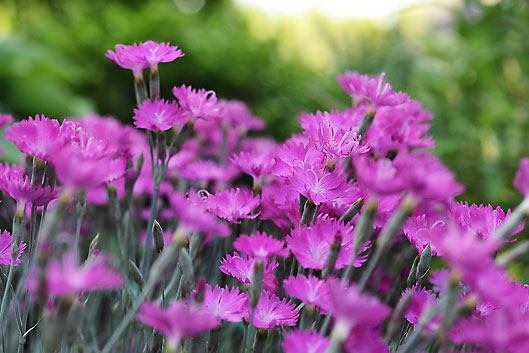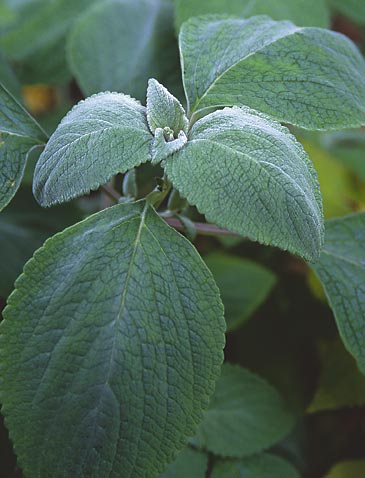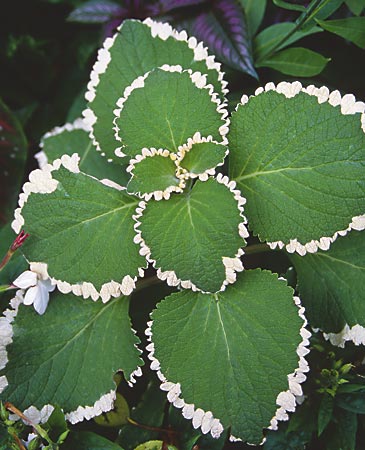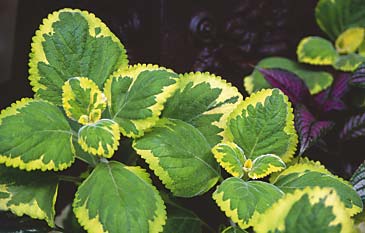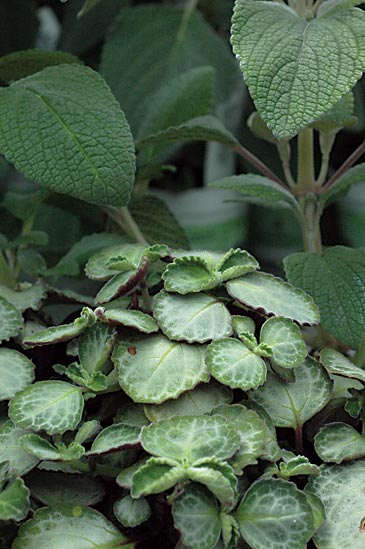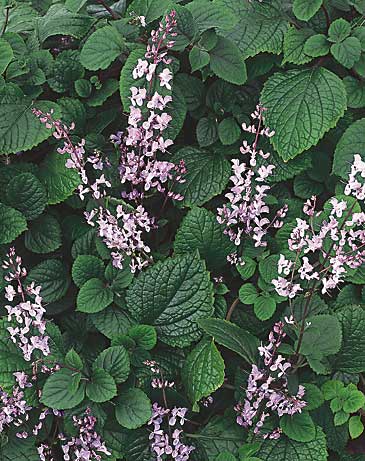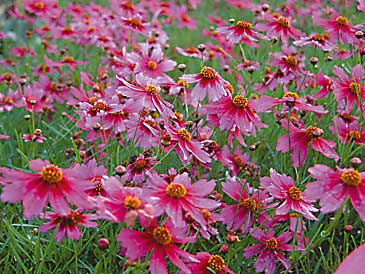 Sunny Border Nurseries
Sunny Border Nurseries
Coreopsis ‘Heaven’s Gate’ by George Papadelis
Many gardeners covet long-blooming perennials. Perennials that bloom for more than six weeks are particularly valuable in gardens with limited space. Fewer varieties can be used to provide the garden with color from early spring until late fall. Within a given genus of perennials such as Salvia, Veronica, or Geranium, there may be various varieties with a broad range of flowering periods. Similarly, tickseed or Coreopsis is a genus that contains some of the most popular long-blooming perennial varieties. All Coreopsis attract butterflies and are easy-to-grow plants derived from American native species.
The most popular species is Coreopsis verticillata or thread-leaf coreopsis. This species contains several varieties, all of which have fine, “thread-like” foliage. The variety “Moonbeam” was chosen by the Perennial Plant Association as the Perennial Plant of the Year in 1992. It grows 12 to 18 inches tall, 24 inches wide, and produces a myriad of pale yellow, daisy-like flowers. It begins blooming in early June and will continue to flower for about 10 to 12 weeks. Removing the spent flowers can further prolong flowering. This practice, however, is seldom considered worthwhile due to the profuse flowering of the typical ‘Moonbeam.’
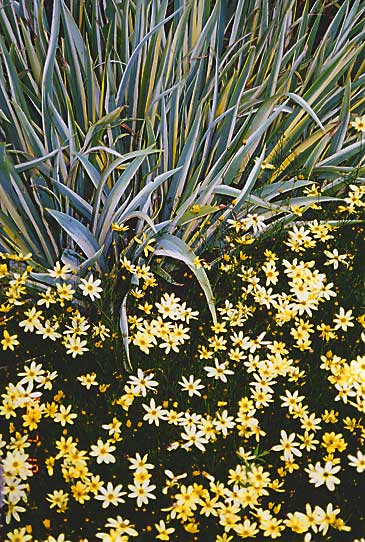 Eric Hofley / Michigan Gardener
Eric Hofley / Michigan Gardener
The pale yellow flowers of Coreopsis ‘Moonbeam’ echo the leaves of this variegated iris.The variety ‘Crème Brulee’ has much larger and brighter pale yellow flowers than ‘Moonbeam.’ It grows slightly taller at about 18 to 24 inches tall. It has a thread-leaf that is more coarse than ‘Moonbeam,’ so it can be more prone to floppiness. Plant ‘Moonbeam’ and ‘Crème Brulee’ with summer-blooming blue perennials such as veronica and salvia.
Two other thread-leaf coreopsis are relatively easy to find. ‘Golden Showers’ produces golden yellow flowers shaped like those of ‘Moonbeam,’ but is a much more upright grower. It grows about 24 inches tall and 18 inches wide. Flowering begins in June and persists well into fall. The variety ‘Zagreb’ is bushy and shorter, with bright yellow flowers on 12- to 18-inch plants.
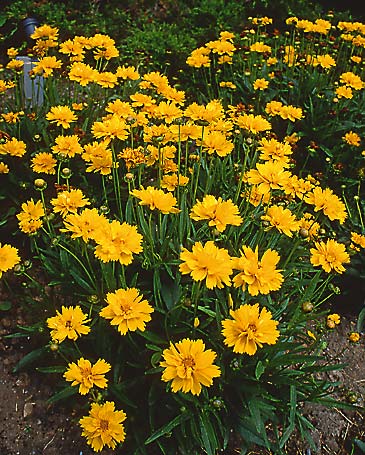 Jonathon Hofley / Michigan Gardener
Jonathon Hofley / Michigan Gardener
Coreopsis grandiflora ‘Sunray’ The shortest species is Coreopsis auriculata, growing only 6 to 10 inches tall. The variety ‘Nana’ is long-lived and begins to bloom earlier than other coreopsis. Flowering begins in May and continues until July. The single orange-yellow flowers develop over a low carpet of rounded leaves. This one is especially well-suited for use as edging or a rock garden plant.
The tallest species is Coreopsis grandiflora. These produce the largest flowers within the genus. They grow from 1 to 3 feet tall and are some of the longest-blooming perennials available. Flowering usually begins in June and continues until September, especially if spent flowers are removed. The drawback is that they are likely to bloom themselves to death; the Coreopsis grandiflora varieties (except for ‘Flying Saucers’) can put so much energy into fall flower and seed production that the weakened plant may not overwinter. The removal of flower stems and seed pods beginning in early September will encourage the development of a strong crown that is more capable of winter survival.
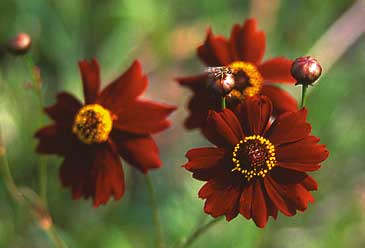 Jonathon Hofley / Michigan Gardener
Jonathon Hofley / Michigan Gardener
Coreopsis ‘Limerock Ruby’ Several varieties of Coreopsis grandiflora exist but these are some of the most noteworthy. ‘Goldfink’ is the shortest Coreopsis grandiflora at only 8 to 10 inches tall. It produces several 1-1/2-inch, single gold flowers. ‘Baby Sun’ (aka ‘Sonnenkind’) is another short variety at 12 to 20 inches tall. It forms a mound of single golden-yellow flowers about 2 inches across. ‘Early Sunrise’ is a former All-America Selections winner and one of the few perennials to receive this distinction. It produces semi-double golden flowers on plants that are 18 to 24 inches tall. ‘Sunburst’ is the tallest Coreopsis grandiflora available at 30 to 36 inches tall. It has larger gold flowers on longer stems and is the best cultivar for cutting.
‘Sterntaler’ offers a unique 2-inch gold flower with a mahogany-brown circle around the center. It grows 16 to 18 inches tall. The variety ‘Tequila Sunrise’ is the only Coreopsis available with interesting green and cream variegated foliage. It produces single gold flowers over plants growing 16 to 18 inches tall. This relatively new cultivar has proven to be somewhat less hardy than others so take precautions such as improving drainage and providing additional winter protection.
Perhaps the most effortless and dependable Coreopsis grandiflora is “Flying Saucers.” This one has sterile flowers that cannot waste energy on seed production. That means it can spend more energy on flower production and gathering strength for overwintering. Golden yellow flowers are produced well into fall and deadheading is far less necessary. Its profuse flowering makes it suitable for use in containers too.
Pink varieties of coreopsis come from the species Coreopsis rosea. The best variety with all pink petals is Coreopsis rosea ‘American Dream.’ Ironically, this plant was the Perennial Plant of the Year in Europe several years ago. It yields several 1-inch, rose-pink daisies with a tiny yellow eye. It grows 8 to 16 inches tall and will bloom until fall if deadheaded. ‘Sweet Dreams’ has large, distinctly bi-colored flowers that combine soft pink petals with a large raspberry pink center. It can grow floppy in more fertile soil, but pruning away the top half will make plants more compact and bushy.
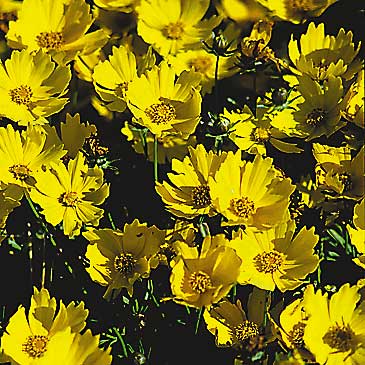 Heritage Perennials
Heritage Perennials
Coreopsis grandiflora ‘Flying Saucers’ A while ago, an exciting new ruby-red coreopsis called ‘Limerock Ruby’ was introduced. Millions were sold all over the world and unfortunately, it became evident that ‘Limerock Ruby’ was not hardy in the colder zones (it is only hardy to about zone 7). Since then, ‘Limerock Ruby’ has tragically become almost impossible to find in most garden centers. It blooms all summer and produces hundreds of flowers. This color is very rare in the flower color palette; only a few plants such as chocolate cosmos and Scabiosa ‘Ace of Spades’ offer blossoms of a similar hue. This plant is certainly worth the effort to track down and perhaps an increase in consumer demand will keep this great annual from disappearing.
Since the demise of ‘Limerock Ruby,’ another selection at least partially fills the void: ‘Heaven’s Gate’ is the deepest pink coreopsis available. It is truly hardy to zone 5 and flowers all summer long.
Coreopsis offers a huge range of different flowers and foliage on plants that display exceptionally long bloom times. In large, English style borders that abound with daisies, lilies, gayfeather, bee balm, and daylilies, coreopsis is a wonderful addition. In smaller gardens, where only a few plants can get squeezed in, high performance perennials like coreopsis are a must.
George Papadelis is the owner of Telly’s Greenhouse in Troy, MI.
At a glance: Coreopsis
Botanical name: Coreopsis (kor-ee-OP-sis)
Common name: Tickseed
Plant type: Perennial
Plant size: 8-36 inches tall, 8-24 inches wide
Habit: Clumping
Hardiness: Zone 4 or 5
Flower color: Pale yellow, golden yellow, pink, deep pink
Flower size: 3/4 to 2-1/2 inches across
Bloom period: Summer to early fall
Light: Sun
Soil: Well-drained
Uses: Perennial border
Companion plants: Blue-flowering perennials like salvia and veronica; daisies, lilies, gayfeather, coneflowers and daylilies.
Remarks: Can be short-lived (a few years). Deadhead spent blooms to prevent seed production, which prolongs the life of the plant.

